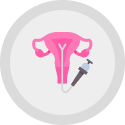Services
 General Obstetric and Gynecological Care
General Obstetric and Gynecological Care

General Obstetrics and Gynecology focuses on primary and preventive care, education on key areas, Gynecologic surgery, and complete obstetrics care. We are equipped to provide a full range of general obstetrical and Gynecological services ranging from outpatient care to surgery and from routine/normal visits to complicated consultations.
Right from the adolescence through the postmenopausal years, our the General Obstetrics and Gynecology services cater to all women issues in a well-equipped and active private office setting.
We carefully assess your health and well-being, accurately diagnose any existing or potential problems that may arise, and offer advanced solutions for medical conditions, such as heavy menstrual bleeding, uterine polyps and fibroids, premenstrual syndrome, and other common problems. Our services include, but are not limited to:
- Pap tests and PapSure, to identify early abnormalities Pap smears may miss
- Clinical breast exams, mammography
- Screening for sexually transmitted diseases (STDs)
- Endometrial ablation – an outpatient procedure to end heavy, painful periods
- Family planning
- Paediatric and adolescent Gynecology
- Genetic counselling and testing
- Easy access to advanced diagnostics, including pelvic ultrasound and hysteroscopy
- Operative hysteroscopy, a minimally invasive outpatient procedure for uterine problems

We care for you – we manage your care during normal pregnancies and counsel patients on family planning/contraception.
 High-risk Obstetrics
High-risk Obstetrics

For females requiring close monitoring during pregnancy, we provide specialised maternal-foetal care. A pregnancy may be considered high-risk if the pregnant woman:
- Is over 35-years; or 15-years-old or younger
- Was underweight or overweight before she became pregnant
- Is carrying more than one foetus
- Has gone into premature labour
- Has had a previous premature baby
- Has had a previous baby with a birth defect
- Has gestational diabetes, diabetes, high blood pressure, heart disease or another longstanding medical problem
 Menopause Treatment
Menopause Treatment

- Menopause treatment aims to manage the symptoms associated with the natural cessation of menstrual cycles in women. Hormone Replacement Therapy (HRT) is a common approach, involving the use of estrogen and, if needed, progesterone to alleviate symptoms such as hot flashes and vaginal dryness. Non-hormonal medications, like SSRIs and SNRIs, may also be prescribed for symptom relief. Vaginal estrogen is an option for addressing localized discomfort. Lifestyle modifications, including a healthy diet, regular exercise, stress management, and adequate sleep, play a crucial role in symptom management. Herbal supplements and counseling may offer additional support.
- Each woman’s experience is unique, and consulting with a healthcare provider is essential to tailor a treatment plan based on individual health considerations and preferences. Regular check-ups and screenings are important for overall health during and after menopause.
 Minimally Invasive Surgery
Minimally Invasive Surgery

- Minimally Invasive Surgery (MIS) is a medical approach that utilizes advanced technology to perform procedures with smaller incisions compared to traditional open surgeries. The primary goal is to minimize trauma to the body, reduce recovery time, and enhance overall patient outcomes. MIS techniques often involve the use of specialized instruments, such as laparoscopes or robotic-assisted systems, allowing surgeons to access and visualize internal structures through small incisions.
- This approach can be applied to various medical disciplines, including gynecology, urology, and orthopedics. Patients undergoing minimally invasive procedures typically experience less pain, reduced scarring, and a quicker return to normal activities, making it a preferred option for many surgical interventions.
 Hysteroscopy
Hysteroscopy

Hysteroscopy is a procedure that lets your doctor look inside your uterus (womb). This is done using a narrow tube-like instrument called a hysteroscope. The hysteroscope is very slim (about 3 to 5 millimetres in diameter). It’s carefully passed through the vagina and cervix (neck of the uterus) and into your uterus. The hysteroscope has a video camera inside which sends pictures to a computer screen. This allows your doctor to check for any abnormalities in the lining of the uterus.
The hysteroscope has special channels which allow the doctor to pass various instruments into the uterus. This means that as well as being able to look inside the uterus, the doctor can perform certain procedures.
What is hysteroscopy used for?
A hysteroscopy may be used to find the cause of various problems such as:
- Heavy or irregular bleeding that has not got better with medication.
- Bleeding in-between periods.
- Bleeding after your menopause.
- Irregular bleeding whilst you are taking hormone replacement therapy (HRT).
- If you are thinking about having an operation to make your periods less heavy (endometrial ablation or microwave ablation).
- Unexplained miscarriages.
Apart from being used to investigate the cause of various problems, it can also be used to:
- Remove polyps – small lumps of tissue growing on the lining of the uterus.
- Remove scar tissue in the uterus.
- Remove adhesions (areas where the walls of the uterus are sticking together).
- Remove fibroids (noncancerous growths in the uterus).
- Locate a ‘lost’ or stuck contraceptive device, such as an IUD (coil).
 Laparoscopy
Laparoscopy

Laparoscopy is a procedure to look inside your abdomen by using a laparoscope. A laparoscope is like a thin telescope with a light source. It is used to light up and magnify the structures inside the abdomen. A laparoscope is passed into the abdomen through a small incision (cut) in the skin.
A laparoscopy may be done to find the cause of symptoms such as abdominal pain, pelvic pain, or swelling of the abdomen or pelvic region. Or, it may be done if a previous test such as an X-ray or scan has identified a problem within the abdomen or pelvis.
A laparoscopy enables a doctor to see clearly inside your abdomen. Some common conditions which can be seen by laparoscopy include:
- Endometriosis
- Pelvic inflammatory disease
- Ectopic pregnancy
- Ovarian cyst
- Appendicitis
What Is Laparoscopic Surgery?
In addition simply to looking inside, a doctor can use fine instruments which are also passed into the abdomen through another small incision in the skin. These instruments are used to cut, trim, biopsy, grab, etc, inside the abdomen. This laparoscopic surgery is sometimes called ‘key-hole surgery’ or ‘minimal invasive surgery’. Laparoscopic surgery can be used for various procedures.
Some commonly performed operations include:
- Removal of Uterus and ovaries – this is called Laparoscopic hysterectomy
- Removal of ovarian cysts
- Removal of patches of endometriosis and adhesions
- Genital cancer surgery
- Female sterilisation
- Treating ectopic pregnancy
- Taking a biopsy (small sample) of various structures inside the abdomen which can be looked at under the microscope and/or tested in other ways
In general, compared with traditional surgery, with laparoscopic surgery there is usually:
- Less pain following the procedure
- Less risk of complications
- A shorter hospital stay and a quicker recovery
- A much smaller scar
 Endometrial ablation
Endometrial ablation

- Endometrial ablation is a medical procedure designed to treat abnormal uterine bleeding by removing or destroying the lining of the uterus (endometrium). This is often considered for women with heavy menstrual bleeding who haven’t responded to other treatments.
- During the procedure, various techniques may be employed, such as laser energy, radiofrequency, or freezing, to target and eliminate the endometrial tissue. The goal is to reduce or stop menstrual flow altogether.
- Endometrial ablation is typically a minimally invasive alternative to a hysterectomy, avoiding the complete removal of the uterus. It is not a suitable option for women who desire future fertility, as it significantly reduces the chances of successful pregnancy.
- While endometrial ablation is generally effective in reducing menstrual bleeding, it may not be suitable for everyone, and potential risks and benefits should be thoroughly discussed with a healthcare provider before opting for the procedure. Common side effects include temporary discharge and cramping, and it’s important to use contraception afterward since pregnancy can pose risks after endometrial ablation.
 Non-incisional sterilization for permanent contraception
Non-incisional sterilization for permanent contraception

- Non-incisional sterilization, also known as hysteroscopic sterilization or non-surgical sterilization, is a minimally invasive method for achieving permanent contraception in women. Unlike traditional surgical sterilization procedures that require incisions, non-incisional sterilization is performed through the cervix, avoiding any external cuts.
- The procedure involves the insertion of a tiny device, such as the Essure or Adiana system, into the fallopian tubes. These devices induce the growth of scar tissue that eventually blocks the tubes, preventing eggs from reaching the uterus and thus achieving permanent contraception. The entire process is typically done in an outpatient setting without the need for general anesthesia.
- Non-incisional sterilization offers advantages such as a quicker recovery time, reduced pain, and avoidance of abdominal incisions. However, it is important to note that this method requires confirmation of tubal blockage through imaging or other tests after the procedure to ensure its effectiveness.
- As with any permanent contraception method, individuals considering non-incisional sterilization should thoroughly discuss the procedure’s benefits, risks, and potential alternatives with their healthcare provider to make an informed decision based on their individual health and reproductive goals.
 Cosmetic Gynecology
Cosmetic Gynecology

Dr. Suman, with her rich background in traditional Obstetrics and Gynecology, recognized the evolving healthcare needs of women. She expanded her expertise into Cosmetic Gyn ecology, a growing field focused not only on beautification but also on restoring functionality to the vulva, vagina, and breasts. This specialty addresses changes in these areas due to aging, childbirth, physical trauma, or genetic factors, which can affect a woman’s self-esteem and sexual well-being. Dr. Suman’s approach in Cosmetic Gynecology is holistic, aiming to enhance both physical appearance and reproductive health, thereby boosting emotional wellness and confidence. Her qualifications in this field are backed by international and national diplomas in Aesthetic or Cosmetic Gynecology, ensuring a comprehensive and empathetic approach to women’s health.

